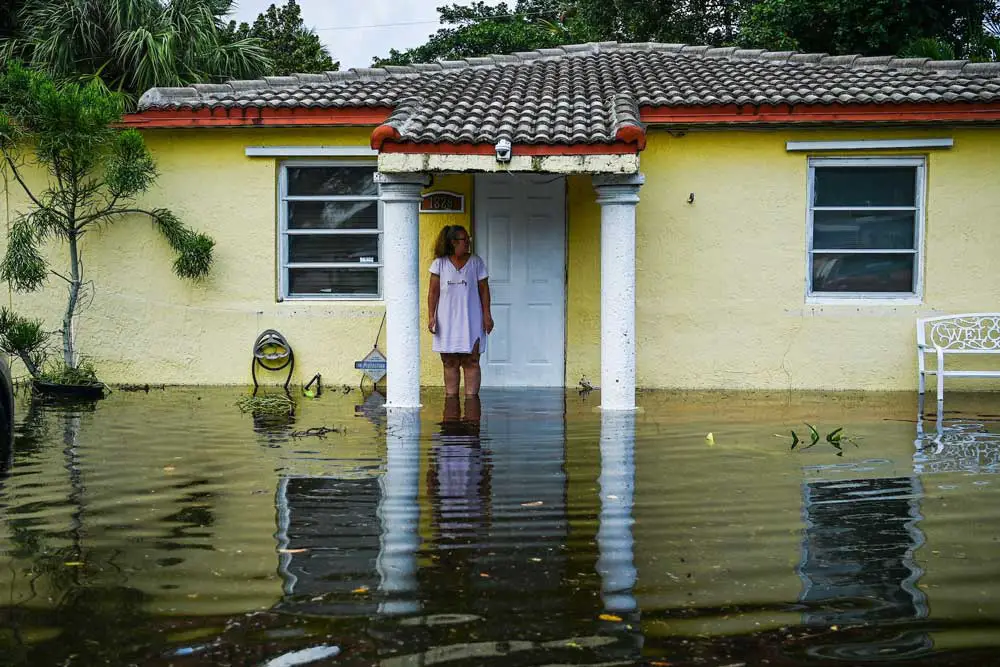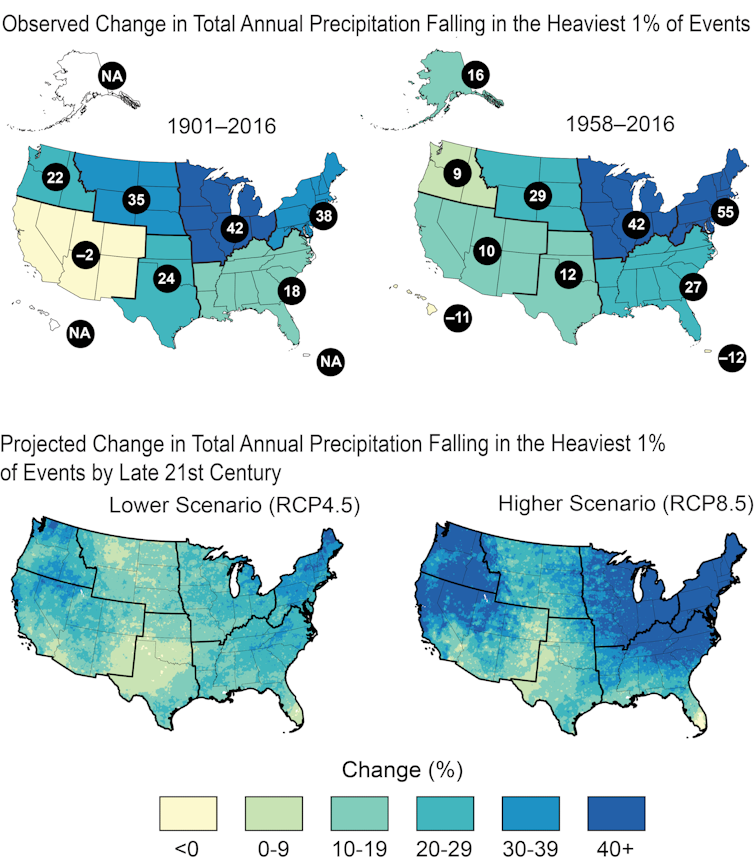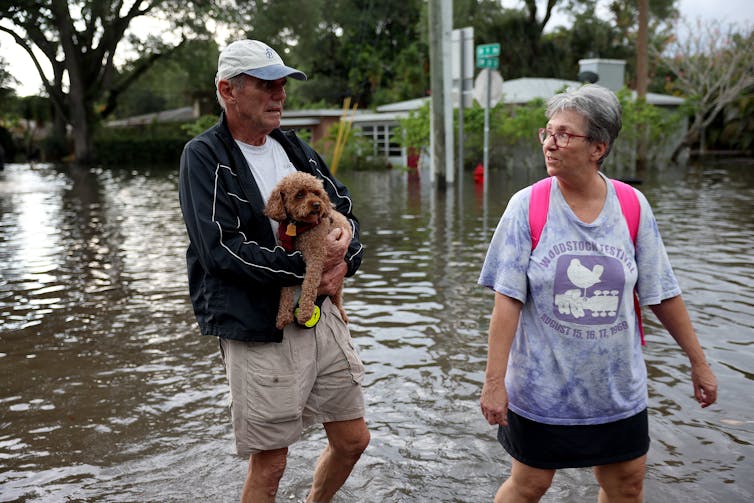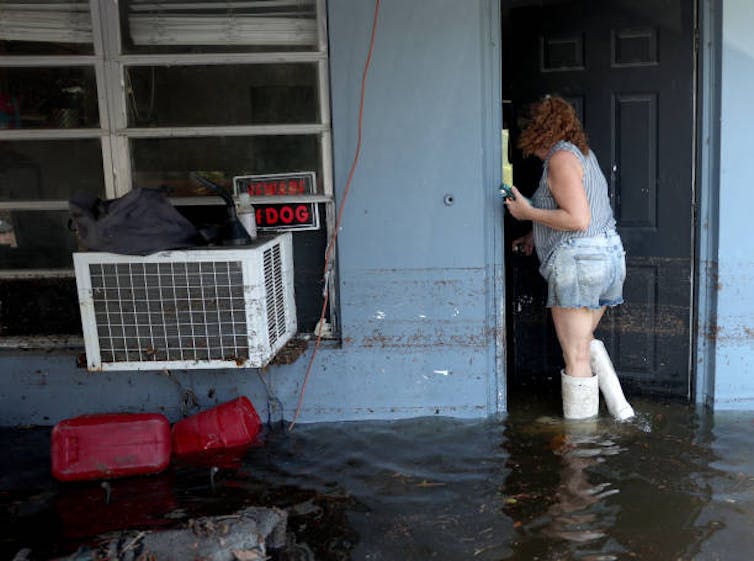
By Smitha Rao
When a powerful storm flooded neighborhoods in Fort Lauderdale in April with what preliminary reports show was 25 inches of rain in 24 hours, few people were prepared. Even hurricanes rarely drop that much rain in one area that fast. Residents could do little to stop the floodwater as it spread over their yards and into their homes.
Studies show that as global temperatures rise, more people will be at risk from such destructive flooding – including in areas far from the coasts that rarely faced extreme flooding in the past.
In many of these communities, the people at greatest risk of harm from flash flooding are low-wage workers, older adults and other vulnerable residents who live in low-lying areas and who have few resources to protect their properties and themselves.
I study the impact of extreme weather on vulnerable communities as an assistant professor of social work. To limit the damage, communities need to know who is at risk and how they can be better prepared.
More extreme downpours in a warming world
The Fort Lauderdale storm on April 12-13, 2023, offered a view into the risks ahead as temperatures rise.
A warmer atmosphere can hold more moisture, leading to stronger downpours. The resulting deluges can be devastating. These events are expected to increase in frequency and intensity in many regions as greenhouse gas emissions from human activities continue to heat up the planet.

National Climate Assessment 2018
Recent disasters, including several in 2022 and in 2023 already, show how the risk of flash flooding is expanding beyond areas traditionally considered at risk.
Knowing who is most at risk
To plan for extreme weather, it’s crucial for community leaders and residents to know where the risks are highest and who might not be prepared.
Low-lying areas with poorly planned development, lack of investment in protective infrastructure and the lingering effects of historic disinvestment and discrimination are often at higher risk. So are low-income communities with tight budgets that can’t afford protective measures like upgraded levees or stormwater systems and can’t recover from damage quickly.
When older adults live in these flood-prone areas, they are at even higher risk. Older adults have a higher likelihood of having health needs or some form of disability that could affect their ability to leave quickly during a disaster. They are also more likely to be socially isolated, which may mean they don’t hear timely information or have help to evacuate or quick access to resources for recovering.

Joe Raedle/Getty Images
Renters and the impact of housing insecurity
In a recent study, my colleagues and I looked at how prepared people were for disasters of any kind across the U.S. – flooding, tornadoes, hurricanes and others – and how housing security played a role. The numbers were sobering.
Overall, we found 57% of the population, among 29,070 housing units surveyed nationwide, reported they were not prepared with food, water, emergency funds and transportation in case disaster struck. We found that households facing housing insecurity – those behind on their payments for rent, mortgage or utilities – were less prepared for disasters than others, even when the occupants had similar incomes and educations.

Joe Raedle/Getty Images
People who are struggling to meet day-to-day needs often don’t have the ability and resources to plan for everyday events, let alone for disasters. Our research has shown that households with children, households led by women, and low-income households were less prepared than others for disasters.
Renting adds additional challenges. In the U.S., lower-income families often depend on the rental market. They tend to move more frequently, and since they don’t own the property, they often can’t make upgrades for safety. And landlords might not prioritize those risks that seem rare but carry costs.
How to help communities stay safe
The most effective way to address these challenges is through solutions that are tailored to the community.
That can involve investing in infrastructure, including state-funded priorities like drainage systems and large-scale flood prevention measures, as well as ensuring that people have access to safe and affordable housing. Some communities and federal agencies have bought out properties that frequently flood and changed zoning rules to prevent more people from moving into harm’s way.
Raising community awareness about climate change and extreme weather risks is also crucial, especially among those most at risk, such as older adults. If people understand the risks, know how to prepare their homes, know how to plan for emergencies and know where to find assistance, they’re more likely to be prepared when disasters strikes.
I believe the most successful efforts are those that bring at-risk communities into planning discussions.
For example, in Columbus, Ohio, the city is working with the Central Ohio Area Agency on Aging, Age Friendly Innovation Center and my team to improve disaster preparedness among older residents. We hope to learn from older adults in affordable housing communities who have experienced extreme weather in recent years to help design action plans for communities with special needs. The goal is to ensure residents are better prepared for climate- and weather-related emergencies in the future.
![]()
Smitha Rao is Assistant Professor of Social Work at The Ohio State University.





























Sally says
Flooding in Ft. Lauderdale and no word from the Governor who is traveling around the world with his wife on Florida taxpayers money. And then he has the Boys Club sign into law he can run for President without resigning from his governor’s position. He is out for himself.
He is hurting businesses to want to come to Florida after his attack on Disney. Have you noticed its his way or no way.
JOE D says
Part of the problem for Flagler Beach ( and surrounding areas) is that the intracoastal waterway flows NORTH to Jacksonville, before going out to sea….so all the flood waters from south of us (Miami, Fort Lauderdale, Palm Beach) has to flow past Flagler Beach, causing DELAYED flooding after a main event. The very things that draw people to the Flagler Country area ( boat docks, canals, water front property) are the exact reason why we are so at risk from flooding.
As was mentioned in the recent Flagler Beach Commission meeting through an EXCELLENT very detailed description of the Flagler Beach overwhelmed water drainage system by the City’s Maintenance director, the main problem is Storm surges ( which the City can only deal with to a limited degree), and poor drain off of storm water, due to a SEEMINGLY poor designed original system (poor drainage angles of installed pipes), and years of delayed maintenance ( due to funding limitations) on drainpipes and holding ponds.
Unfortunately one of our City Commissioners ( who was late and missed most of the DETAILED presentation) took that opportunity to point the finger at our already OVERWHELMED and UNDERFUNDED maintenance department, and was unfortunately joined by the Commission Chair.
They pointed out that the system needed maintenance “6 months ago.” And that nothing has been done. I try to virtually attend all those Commission meetings, I remember the discussion, but I also don’t remember FUNDING being released from the water management budget NOR the City RESERVE fund at the time to PAY for it. It was hinted (I might be wrong) that the maintenance director come up with a plan….which he most professionally DID. NOW it appears those funds have been released.
The “elephant in the room” so to speak, is that no amount of City intervention is going to prevent sea level rise, and increased flooding in the southern part of town (especially in the western section ) unless homes are ELEVATED! There is a federal program that will pay between 75% and 100% of that cost depending on your property repetitive flood risk. There is a TIME limit for those funds!
When I looked for a Flagler Beach home in retirement, I insisted on a raised elevation ( in my case, first living level 8 ft off the ground)…and was AMAZED at the LACK of elevated homes in a coastal area prone to hurricane and storm flooding. Since the 1980’s-1990’s, all new coastal construction in the States of Maryland and Delaware had to be elevated 8-10 ft above the ground! Even with the 2005 Florida new construction changes….most of it dealt with WIND, and not FLOODING!
There is only so much Flagler Beach can do with STORM water SURGE, and the initial plans for clearing the drains and dredging the retention ponds should offer a fix for the rain water run off.
But, there is little we can do to totally reverse man made climate change a sea level rising without efforts far beyond FLAGLER Beach capabilities.
DaleL says
I fully agree with JOE D about the importance of elevated homes in coastal areas. Before our house was built, we researched the flooding potential. At significant cost, we had three feet of fill added to our lot to raise our home’s floor to 3 feet above the BFE (Base Flood Elevation). This has saved us money in flood insurance. Also, when hurricane Matthew (2016) flooded our neighborhood streets, our house was high and dry. Not all of our neighbors homes were so lucky.
I am also AMAZED by the number of people who fill their garages with junk and park their expensive vehicles outside! The recent hail storms have demonstrated how foolish that can be.
All new housing units, whether homes, apartments, or condos, need to be properly elevated and should include covered parking.
Laurel says
DaleL: Many of the older properties were not elevated, as they did not have this problem so much until lately. When a new home is built, it is elevated and the rain runoff goes onto the neighbor’s property. Each new property should be required to keep all runoff on their property though swales, rain gardens and the like.
That said, I don’t believe that Palm Coast is a good development area, but, you know. Developers.
Laurel says
Joe D: The only Florida river that runs from south to north is the St. Johns River, which is highly unusual. The Intracoastal Waterway does not run south to north. In addition, there are several inlets along the coast that allow the tide to come in from the ocean and go out to the ocean. South Florida’s water also is tidal in the ICW, and water is often let out to Lake Okeechobee and the Everglades via South Florida Water Management District, and Lake Okeechobee’s overflow is often diverted to the Gulf of Mexico via Southwest Florida Water Management District, much to the chagrin of the locals there, rightfully so as it aides in algae blooms. South Florida’s water does not effect us. Not sure who told you that.
Michael Cocchiola says
Only when the waterfront properties of wealthy homeowners flood regularly and disastrously will climate change be taken seriously.
Laurel says
Michael: Doubt it. Much of the wealthy Florida homes are on the coastal edge, which is often barely 3′ above sea level on normal days. This is where I disagree with the author of the article. I lived in Ft. Lauderdale most of my life, and knew people at the beach as well as out west. Never, I mean never, have I seen anything like this flood! Miami Beach was the first of the warnings. This King Tide stuff is on the new side, we didn’t see flooding there either until the last decade or so. Plenty of money there.
The problem is two fold: Development (developers, real estate companies, Chamber of Commerce, etc.) and climate change. Look how Flagler County is developing. It’s coming, same stuff.
don miller says
it is a warning that paid for politicians allow density amendments and re-zonning to pave over land to their campaign contributors. no place for the water to go but into your house; as they cover more open land with fill dirt and concrete to more more bucks than the land can hold.to make it worse the taxpayers get to pay to try and correct what the profit team ruins.
Dave Hinson says
I read your article about the flooding situation in Ft. Lauderdale, and I wanted to express my sympathy to the residents who have been affected by this unfortunate event. Flooding can be incredibly disruptive and damaging, causing significant challenges for both individuals and communities.
It is disheartening to hear about the homes, businesses, and infrastructure that have been impacted by the flooding. The consequences of such events can be far-reaching, ranging from property damage to disruptions in daily life and economic activities.
Addressing and managing the issue of flooding requires a comprehensive and collaborative approach. It involves not only immediate response efforts to assist those affected but also long-term strategies for flood prevention and mitigation.
Investing in infrastructure improvements, such as enhancing stormwater management systems and implementing effective drainage solutions, is crucial to minimize the impact of future flooding events. Additionally, raising awareness about flood risks, encouraging responsible land development practices, and promoting sustainable urban planning can help mitigate the effects of flooding in the long run.
It is also essential for the community to come together and support one another during times of crisis. Providing assistance to those in need, volunteering, and supporting local relief efforts can make a significant difference in helping affected individuals and businesses recover from the aftermath of flooding.
I hope that the city of Ft. Lauderdale, along with relevant authorities and community stakeholders, takes proactive measures to address the flooding issue and ensure the well-being and safety of its residents. By working together and implementing sustainable solutions, we can build resilience and reduce the impact of future flooding events.
Once again, my thoughts go out to the residents of Ft. Lauderdale who have been affected by the recent flooding. I hope that the recovery process is swift and that measures are put in place to prevent similar incidents in the future.
Jacoby Johnson says
I recently read your article titled “Fort Lauderdale Residents Wrestle With Flooding as Seas Rise” on Flagler Live, and I want to express my concern about the persistent flooding issues faced by the residents of Fort Lauderdale. The impact of rising sea levels on coastal cities is a pressing global challenge, and it is disheartening to see the adverse effects on communities firsthand.
The article effectively highlights the experiences and struggles of residents in dealing with the frequent flooding events. It sheds light on the various factors contributing to the problem, including high tides, stormwater management issues, and the vulnerability of low-lying areas to sea level rise. These challenges not only disrupt daily life but also pose risks to public safety, infrastructure, and property.
The urgency to address the impacts of climate change, such as sea level rise and increased flooding, is evident. It is crucial that local governments, urban planners, and community members come together to develop comprehensive and sustainable strategies to mitigate the effects of flooding and enhance resilience in the face of rising seas.
Investing in improved stormwater infrastructure, implementing nature-based solutions, and enhancing coastal resilience measures are key steps in managing the flooding challenges. Additionally, raising public awareness and fostering community engagement are vital components to build resilience and ensure the well-being of residents.
Your article serves as a call to action and highlights the importance of sharing these stories to raise awareness about the impact of climate change on local communities. By amplifying the voices of residents and shedding light on the challenges they face, you contribute to the ongoing conversation on climate resilience and inspire others to take action.
Thank you for bringing attention to the flooding issues in Fort Lauderdale and providing a platform for residents to share their experiences. I hope that through continued collaboration and collective efforts, effective solutions can be found to alleviate the flooding challenges and create a more sustainable future for the community.
Burnice Bauch says
It’s unfortunate to see the impact of flooding in Fort Lauderdale and the challenges it poses to residents and the city’s infrastructure. The article highlights the need for comprehensive planning and investments in flood mitigation measures to address these recurring issues. It’s crucial to prioritize resilience and adaptation strategies to protect the community from the impacts of extreme weather events. Thank you for sharing this important information and raising awareness about the need for effective flood management in Fort Lauderdale.